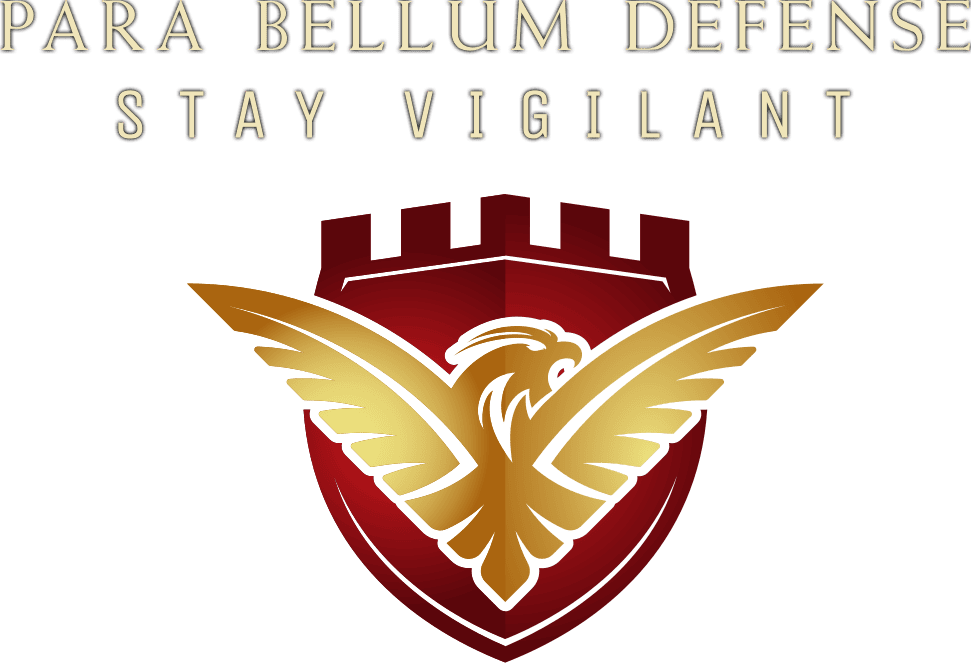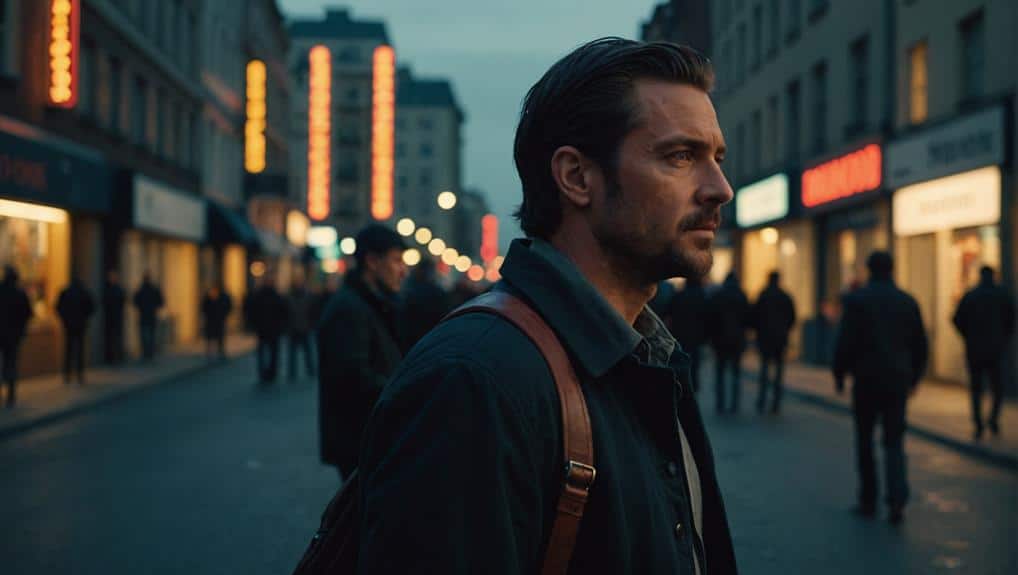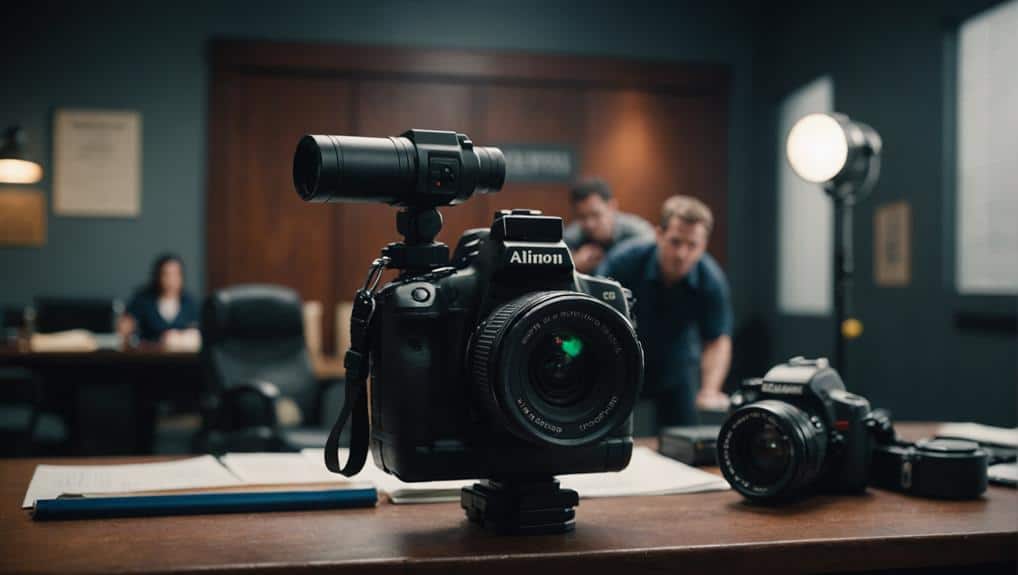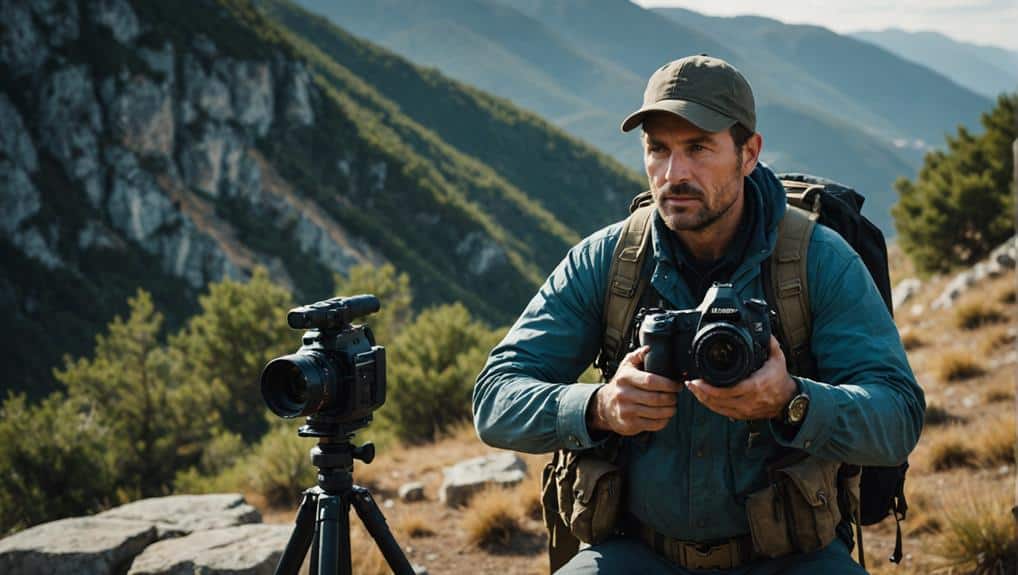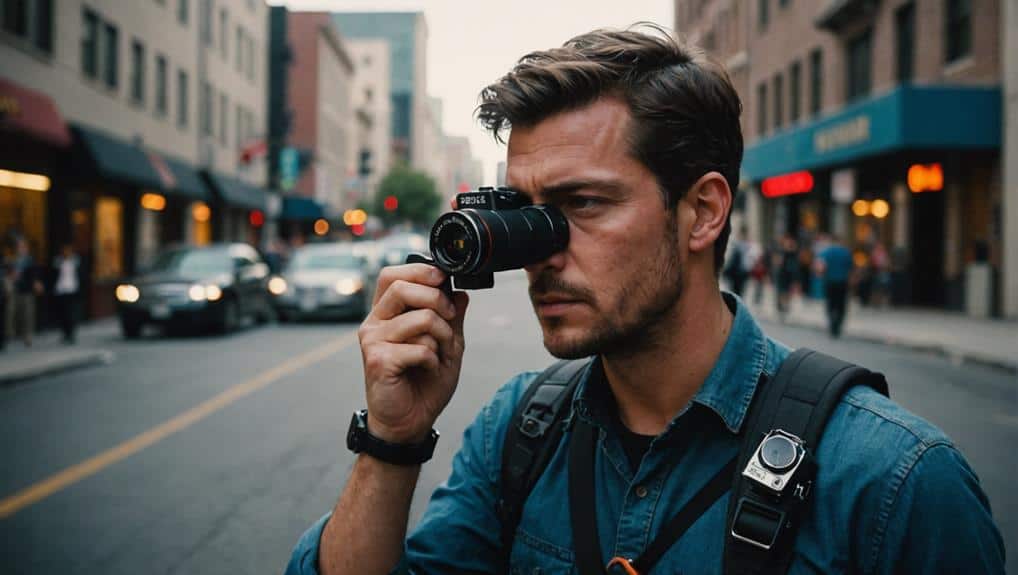As a photographer maneuvering the urban jungle, you’ve got to be prepared for more than just capturing the perfect shot. Ever had a subject get a little too defensive?
Self-defense training can boost your confidence, letting you dodge tricky situations like a pro. Remember to carry a
personal alarm or lightweight knuckle duster, whatever’s legal in your area. Stay sharp by being
aware of your surroundings, making sure your phone’s charged, and having a
backup plan. Follow these tips and you’ll not only snap great photos but keep yourself safe and sound, enthusiastic for the next adventure.
Risks of Street Photography
Street photography can be an exciting and fulfilling pursuit, but it isn’t without its
risks. You’re out there, capturing
candid moments, revealing the raw beauty of everyday life. But sometimes, people might not appreciate being caught on camera. You’ve got to think about your
personal safety while snapping those shots.
Imagine snapping a photo of a bustling market, and suddenly, someone’s in your face, furious. Documented cases show photographers facing aggression from subjects who didn’t want their picture taken. It’s crucial to have
confrontation strategies up your sleeve.
First, always be
aware of your surroundings. Keep an eye on how people react to your presence. If someone looks uncomfortable, it’s best to back off. Maintaining a
respectful distance can save you a lot of trouble. And if a confrontation happens, stay calm. Adopt a non-threatening posture—no sudden movements, no raised voices.
Sometimes, though, things can escalate quickly. If an encounter turns aggressive, you need a plan. Know when to
de-escalate or retreat. It’s not worth risking your safety for a shot. Remember, the streets are
unpredictable, and your personal safety always comes first.
Self-Defense Training Benefits
When you engage in
self-defense training, you’ll not only learn how to protect yourself but also enjoy a host of additional benefits. First off, it’s a fantastic way to
boost your
physical health. Think of it as hitting the gym but with a twist—you’re improving strength,
flexibility, and cardiovascular fitness while learning life-saving skills. Plus, managing stress and aggression in a controlled environment does wonders for your emotional well-being.
Self-defense training also builds
confidence. With each new technique you master, you’ll feel more empowered to navigate risky situations. You’ll walk with your head held high, knowing you’re prepared for whatever comes your way. And let’s not forget the lessons in humility—realizing your limitations keeps your ego in check and makes you more resilient.
But the benefits don’t stop there. You’ll learn how to
de-escalate confrontations, often resolving issues peacefully without resorting to violence. This skill is invaluable, especially in unpredictable scenarios. So, while you’re out there capturing the perfect shot, you’ll have the peace of mind that comes with being
well-prepared. Now, go ahead and give self-defense training a shot—your future self will thank you!
Legalities of Defense Tools
Maneuvering through the
legal landscape of
self-defense tools can be an intimidating task, especially for photographers who often find themselves in unfamiliar locations. Imagine you’re in a new city, capturing the perfect shot, and you suddenly feel threatened knowing the
local laws around self-defense tools is essential. In the U.S., for instance, laws differ by state. While
pepper spray is generally legal in many areas, some states have restrictions. Contrast that with the UK, where carrying pepper spray is illegal because it’s classified as an
offensive weapon. Additionally, certain self-defense tools like the
Fang Keychain Stun Gun offer both portability and utility but may also be subject to local restrictions.
Understanding local laws can be a lifesaver. In some places, you can only use self-defense weapons if there’s an
imminent threat to your safety. This means you need to be sure you’re in the right to protect yourself, or you could face
serious legal consequences.
Firearms are another story entirely. Some states allow open or concealed carry permits, while others have strict regulations or bans.
Cultural attitudes also play a role. Some countries prioritize
non-violent conflict resolution, leading to stricter laws. So, before you pack that pepper spray or
stun gun, make sure you’re familiar with both local and national legalities. Ignorance isn’t bliss—it’s a potential
legal nightmare.
Mental Conflict Resolution
Mastering
mental conflict resolution is vital for photographers who find themselves in
unpredictable environments. Imagine you’re in a bustling market, capturing candid shots, and suddenly, someone feels you’re
invading their privacy. It’s important to maintain mental control and not let emotions spiral.
Understanding and interpreting
body language can be your first line of defense. Notice clenched fists or a tense posture? That’s your cue to
diffuse the situation. Practicing conflict resolution skills can turn a potential showdown into a peaceful conversation. A calm demeanor can work wonders. If you stay composed, the other person is likely to mirror your calmness.
Regularly engaging in
mindfulness or de-escalation techniques sharpens your situational awareness. You’ll react to conflicts not with panic, but with poised confidence. Remember, your goal is to
navigate confrontational encounters without escalating them. So, take a deep breath, assess the situation, and choose your words carefully.
Practical Safety Strategies
When you’re out shooting, being
aware of your surroundings is key—keep an eye out for anything unusual and always know where the exits are. Make sure you’ve got a way to
call for help quickly, like a phone with emergency contacts pre-set, just in case things go south. And, of course, treat your gear like gold; secure it with straps and locks to prevent theft and damage.
Situational Awareness Techniques
Keeping yourself safe as a photographer starts with a keen sense of
situational awareness. It’s all about staying alert and knowing what’s happening around you. Imagine you’re on a shoot, and you’re constantly
scanning your surroundings for
potential threats. This is your
personal safety protocol, and it’s essential. You need to be aware of exits or safe spots in case things go sideways.
Active listening is your secret weapon. By tuning into the sounds around you, you’ll pick up on changes in tone or volume that might signal danger. Maybe someone’s voice suddenly gets louder or more aggressive—these are cues you can’t afford to ignore.
Now, let’s talk about “360-degree awareness.” This technique means you’re not just looking straight ahead but are aware of all angles around you. Picture yourself with eyes in the back of your head, always spotting risks before they escalate.
Mental exercises, like
visualizing different scenarios, can also prepare you for the
unexpected. Think of it as a rehearsal for real-life situations. You’ll be ready to act quickly,
prioritizing your safety above all. So, stay sharp, stay safe, and keep capturing those perfect shots!
Emergency Communication Methods
In the unpredictable world of photography, having robust
emergency communication methods can be a real lifesaver. Imagine you’re out capturing that perfect sunset shot in a secluded area, and suddenly, something goes wrong. Having a solid emergency communication plan can turn a potential disaster into a manageable situation. Consider carrying a
door stop alarm for added security when you are staying in unfamiliar places.
First, make sure you’ve got
designated contacts who can be reached via phone or messaging apps in case of a safety incident. Apps like
Life360 or
bSafe are fantastic options—they let you share your location and send emergency alerts to your chosen contacts in real-time. Trust me, these apps are lifesavers!
You’ll also want to invest in a
portable power bank. There’s nothing worse than your phone dying when you need it most, right? Keep that battery charged so you’re never out of touch during those extended shoots.
Don’t forget to familiarize yourself with
local emergency numbers. It’s critical to have them saved in your phone for
quick access, especially since these can vary by region. Finally, consider carrying a
whistle or
personal alarm. These simple tools can draw attention and alert others if you find yourself in a threatening scenario while out photographing.
Safe Equipment Practices
While robust emergency communication methods are essential, the safety of your equipment is equally important. Imagine this: you’re on a Full Frame photo shoot, surrounded by curious onlookers. Keeping your gear safe can be a completely different challenge in such environments. First, invest in protective gear like padded camera bags and lens caps. These help shield your equipment from bumps and scratches during transport and while shooting in public spaces.
Scout your location beforehand to identify potential risks. Knowing where emergency exits and nearby help are can save you precious time if things go south. A lightweight, discreet camera strap not only makes your gear easier to carry but also deters theft. Plus, it allows you to access your camera quickly when you spot that perfect shot.
Regular maintenance is your best friend. Check your gear for any wear or damage before every shoot. The last thing you want is your camera malfunctioning at a critical moment. Finally, avoid drawing unnecessary attention to your expensive gear. Use less conspicuous equipment and blend into your surroundings. This way, you minimize the risk of theft or confrontation, letting you focus on capturing that stunning image.
Building Client Trust
A handshake at your first meeting with a client can be the first step in building trust and setting the foundation for a successful relationship. From that moment, your approach should focus on client satisfaction and employing trust building techniques. Open communication throughout the photography process, from the initial inquiry to post-wedding follow-ups, makes clients feel valued and informed.
Pre-wedding meetings are essential. They help confirm details and set clear expectations, showing your clients you’re invested in their special day. When clients know what to expect, they’re more likely to trust you and feel emotionally engaged. This emotional engagement can greatly boost your chances of selling wedding albums and photos.
Here are some key strategies to build client trust:
- Communicate effectively: Keep clients in the loop from start to finish.
- Show genuine interest: Understand their unique stories to capture genuine emotions.
- Leverage your network: Maintain relationships through digital platforms to increase referrals.
Public Photography Precautions
After building a
strong foundation of trust with your clients, it’s important to shift your focus to
ensuring safety while photographing in public spaces. First off, always be
aware of your surroundings. Whether you’re doing some urban exploration or a simple street shoot, keeping an eye out for
potential threats is essential. You don’t want to end up in a confrontational situation because you were too engrossed in getting the perfect shot.
Developing a
safety plan is another key step. Know your exits, have
emergency contacts ready, and carry self-defense tools like personal alarms or knuckle accessories. These can be lifesavers in risky environments. And remember,
photography etiquette isn’t just about being respectful to your subjects, but also about engaging with the community. Share safety tips with other photographers and foster a sense of collective awareness.
When faced with aggressive individuals,
de-escalation techniques can be your best friend. Stay calm, use respectful body language, and try to diffuse the situation. Trust me, a little bit of courtesy can go a long way in keeping things peaceful.
Embracing Continuous Learning
To truly excel as a photographer, embracing continuous learning is essential. It means constantly evaluating your work, identifying areas for improvement, and setting specific goals to enhance your skills. Engaging in photography workshops, online courses, and community groups can provide you with invaluable insights from seasoned photographers. These experiences often lead to skill enhancement and a deeper understanding of your craft.
Staying updated on the latest photography trends, techniques, and technology is vital. The industry evolves quickly, and being adaptable helps you stay relevant. Regularly participating in constructive feedback exchanges with peers can refine your photographic style and approach, creating a supportive learning environment where everyone benefits.
Consider these steps to get started:
- Join photography workshops: Learn new techniques and gain inspiration from experts.
- Seek constructive feedback: Share your work with peers and learn from their perspectives.
- Document your journey: Keep track of your experiences and lessons for future reference.
Through continuous learning, you not only improve your technical skills but also foster creativity and resilience. So, never stop exploring and challenging yourself—your growth as a photographer depends on it!
Frequently Asked Questions
How Do I Make Myself Stand Out as a Photographer?
To stand out as a photographer, develop a unique style that showcases your creativity. Use consistent branding techniques across all platforms. Implement effective networking strategies by engaging with industry professionals and potential clients to build strong connections.
How Should a Photographer Handle a Camera to Prevent Motion?
Oh, you think you can just grab a camera and become Ansel Adams, huh? Use camera stabilization techniques, choose a sturdy tripod, and master handheld shooting methods like steady grip and proper breathing to prevent motion blur.
How to Be a Professional Photographer?
To be a professional photographer, establish clear client communication, develop a strong portfolio showcasing your unique style, and seize networking opportunities. These steps foster trust, attract clients, and build relationships for referrals and collaborative projects.
How to Start Getting into Photography?
“Rome wasn’t built in a day.” Start with beginner gear like a DSLR, learn photography techniques such as aperture settings, and seek creative inspiration through online tutorials and communities. Practice consistently to develop your skills and unique style.
